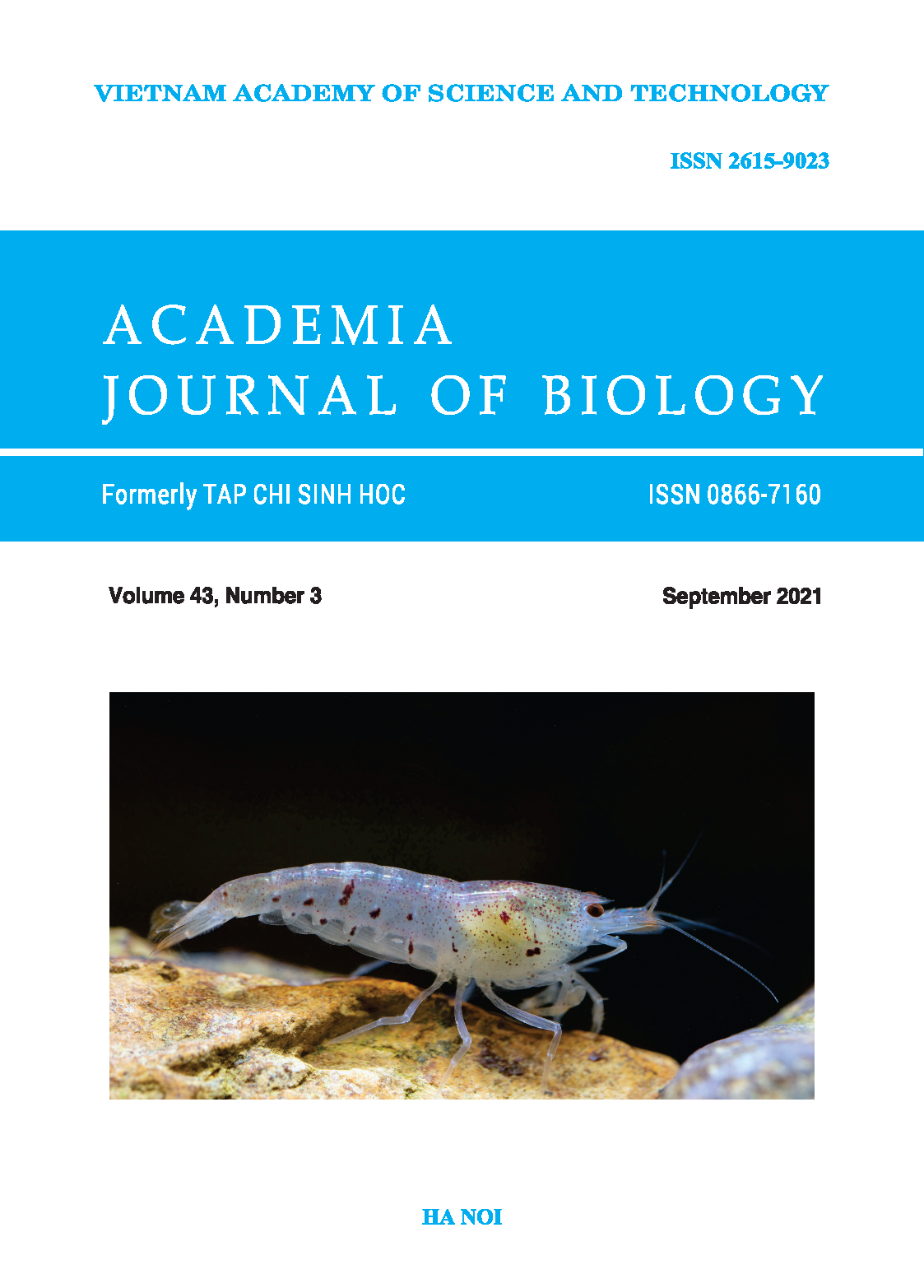\(\textit{rbc}\)L DNA region revealed as the best DNA barcode for identification of \(\textit{Mahonia}\) and \(\textit{Berberis}\) species (Berberidaceae)
Author affiliations
DOI:
https://doi.org/10.15625/2615-9023/15888Keywords:
Berberidaceae, ITS2, rbcL, trnH-psbA, selection of candidate DNA markers.Abstract
Berberidaceae contains 17 genera and nearly 650 species, in which the genus Berberis and the genus Mahonia are sisters with a very close relationship and share many similar characteristics. In the past, the two genera were merged into the genus Berberis. At present, the Berberidaceae is at risk and is prioritized for conservation, especially the species of Mahonia and Berberis. In the fact, identification for the Berberidaceae species based on the morphology of parts for sale (such as roots, stems, leaves) without reproductive organs (flowers and fruits) is impossible.
In recent years, molecular biology techniques are being applied widely and effectively in research on the evolution, classification and genetic diversity of populations. Study based on DNA has highly accurate and particularly useful for closely related species which morphological observations are not sufficient to distinguish. Results from DNA analysis allow authentic species, populations or individuals from un-intact specimens accurately and especially, it is not affected by objective factors such as the environment or human.
In this study, we assessed the taxonomy ability of three commonly DNA barcoding regions used for classification including rbcL, trnH-psbA and ITS2 on 12 samples of the Berberidaceae family, in which 7 samples are genus Mahonia, 4 samples are genus Berberis and one sample of Epimedium was used as the control sample. The results of the study will contribute to the selection of suitable DNA barcode for the identification of Mahonia and Berberis samples.
The results demonstrated that the rbcL region showed the most obvious ability to distinguish the 12 Berberidaceae species. The ITS2 sequences of Berberis julianeae and Mahonia bealei of Vietnam were submitted to GenBank with accession numbers MT073031 and MT008067, respectively. The sequence of rbcL of Mahonia bealei was also submitted to GenBank with accession number MT457415.1.
Downloads
References
Ban Nguyen Tien, 2003. List of plant species in Vietnam. Volume 2. Agricultural Publishing House, Hanoi.
CBOL Plant Working Group, 2009. A DNA barcoding for land plants. PNAS, 106(31): 12794–12797.
Chen S., Hui Y., Jianping H., Chang L., Jingyuan S., Linchun S., Yingjie Z., Xinye M., Ting C., Xiaohui P., Kun L., Ying L., Xiaocheng J., Yulin L., Christine L., 2010. Validation of the ITS2 region as a novel DNA barcode for identifying medicinal plant species, PLoS One, 5(1): e8613.
Cheng T., Chao X., Li L., Changchao L., Yu Z. and Shilian Z., 2016. Barcoding the kingdom plantae: new PCR primer for ITS region of plants with improved universality and specificity. Molecular Ecology Resources, 16: 138–149.
Chromas Pro2.1.6. https://chromas.software. informer.com/download/.
Doyle J. J., Doyle J. L., 1990. Isolation of plant DNA from fresh tissue. Focus, 12: 13–15.
He J. M., Mu Q., 2015. The medicinal uses of the genus Mahonia in traditional Chinese medicine: An ethnopharmacological, Phytochemical and pharmarcological review. J. Ethnopharmacol, 175: 668–683.
Kress W. John, Kenneth J. Wurdack, Elizabeth A. Zimmer, Lee A. Weigt, and Daniel H. Janzen, 2005. Use of DNA barcodes to identify flowering plants. Proceedings of the National Academy of Sciences, 102(23): 8369–74.
Kumar S., Stecher G., Tamura K., 2016. MEGA7: Molecular evolutionary genetics analysis version 7.0 for bigger datasets, Molecular Biology and Evolution, 33(7): 1870–1874.
Lahaye R., van der Bank M., Bogarin D., Warner J., Pupulin F., Gigot G., Maurin O., Duthoit S. Barraclough T.G., Savolainen V., 2008. DNA barcoding the floras of biodiversity hotspots, Proceedings of the National Academy of Sciences of the United States of America, 105: 2923–2928.
Liu J., Provan J., Gao L. M., Li D. Z., 2012. Sampling strategy and potential utility of indels for DNA barcoding of closely related plant species: A case study in taxus, International Journal of Molecular Sciences, 13: 8740–8751.
Muellner A. N., Schaefer H., Lahaye R., 2011, Evaluation of candidate DNA barcoding loci for economically important timber species of the mahogany family (Meliaceae). Molecular Ecology Resources, 11(3): 450–460.
Nguyen Thi Phuong Trang, N. M. Duc, N. V. Sinh, Triest L., 2015. Applictaion of DNA barcoding markers for identification of Hopea species. Genetic Molecular Research (GMR) 14(3): 9181–9190.
Stoeckle M. Y., Catherine C., Gamble R., Kirpekar G. Y., Selena A., Damon P. L., 2011. Commercial teas highlight plant DNA barcode identification successes and obstacles. Nature Research Journal, 1(42): 1–7
Song X., Ting S., Wenjie L., Xiaopeng N. Shahid I., Zhaojun N., Xiao H., Dan Y., Zhijun S. And Zhihong G., 2019. Comparative analysis of the complete chloroplast genome among Prunus mume, P. armeniaca, and P. salicina. Horticulture Research, 6(89): 2–13.
Young Dong Kim, Robert K. Jansen, 1996. Phylogenetic implications of rbcL and ITS sequence variation in the Berberidaceae. Systematic Botany vol 21(1): 381–396.
Young Dong Kim, Sung Hee Kim, Chul Hwan Kim, Robert K. Jansen, 2004. Phylogeny of Berberdaceae based on sequences of the chloroplast gene ndhF. Biochemistry Systematics and Ecology, 32: 291–301.
Vietnam Ministry of Sciences and Technology, 2007. Vietnam Red Book Part II - Plants. Natural Science and Technology Pub., Hanoi.
Downloads
Published
How to Cite
Issue
Section
License
Academia Journal of Biology (AJB) is an open-access and peer-reviewed journal. The articles published in the AJB are licensed under a Creative Commons Attribution-NonCommercial-NoDerivatives 4.0 International License (CC BY-NC-ND 4.0), which permits for immediate free access to the articles to read, download, copy, non-commercial use, distribution and reproduction in any medium, provided the work is properly cited (with a link to the formal publication through the relevant DOI), and without subscription charges or registration barriers. The full details of the CC BY-NC-ND 4.0 License are available at https://creativecommons.org/licenses/by-nc-nd/4.0/.












